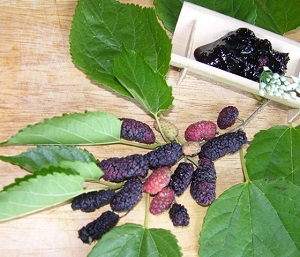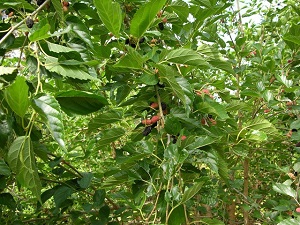From Fairchild
Tropical Botanic Garden
by Noris Ledesma, Curator of Tropical fruit
The
Red Mulberry: A Bird Attracting Plant for South Florida
As published in the Miami Herald
Red mulberry (Morus rubra),
a
native of South Florida, has found its way to New York and the central
parts of Ohio, Indiana, Illinois and Missouri. In Florida the red
mulberry grows wild in dry fields, pinelands and moist woods, where
they can form a thicket of rapid-growing trees. The mulberry grows well
in South Florida and needs little care. It hybridizes frequently with
white mulberry but it does not usually have a long life, as it will be
damaged by winds and succumb to disease in less than 20 years, in most
cases.

The
red mulberry tree brings ample shade to our Florida yards and attracts
wildlife with its fruit. The small, sweet fruits are a favorite food
for most birds. The mulberry was also used by the native people of the
eastern United States for centuries. There are records of the Timucua
Indians of northeast Florida using the leaves, twigs and berries to
make dyes, and Seminoles using the branches to make bows. Other Indians
more to the north consumed the dried fruits during the winter. They
would mash, dry and store mulberry fruit, then add them to water to
make warm sauces that they sometimes mixed into cornbread. The Cherokee
made sweet dumplings by mixing cornmeal and sugar with the fruit. In
the past, the fruits were also valued for fattening hogs and chickens
but this practice is rarely used today.
Red mulberry can have
both male and female trees as well as male and female flowers on the
same tree. Only female trees or those with both male and female blooms
will produce fruit. In South Florida, the red mulberry blooms in April
and May, and fruit reaches full development from June to September
depending on the cultivar. Each fruit is composed of many small
drupelets. The fruit is excellent with its honey sweet flavor. The best
way to consume it is by picking directly off the tree and eating out of
hand - if you can fend off the birds that are competing for the same
prize! The fruits contain high concentrations of sugar that make them
useful to process for jams, jellies and pies.

Here
in Florida, trees were widely planted for the production of fruit as a
food source and as feed for livestock in years past. When I ask people
who have it growing in their back yard, they say it brings back
memories from their childhood. There are many legends and folklore
associated with the mulberry in the Unites States as a whole and of
course here in Florida. The wood from Mulberry trees has also been used
in the construction of furniture, boats and tubs and even as fence
posts because the heartwood is relatively durable. Other uses of the
wood include farm implements, furniture, interior finishing and
caskets. So if you ever tire of eating your mulberries there are many
uses for your trees.
Red mulberry is a small to
medium sized tree, with a rounded, dense canopy and short trunk. The
bark is light to dark reddish-brown, separating into narrow, loose,
flat strips and shallow, flat fissures. Native Americans used the
fibrous bark to make cloth and it can provide children with hours of
craft fun.
Red mulberry can be propagated from stem cuttings,
root sprouts, air-layering or by budding. Young plants need extra
phosphorous to encourage good root development. The red mulberry tree
is a colonized species that require full sun to survive. Pruning and
thinning can extend the fruiting season and rejuvenate the tree by
maintaining size and good shape. Doing this avoids the need for more
severe pruning later on.
Floridians have been selecting trees
for years, and they are many selections available in South Florida,
including the delicious ’Fairchild’ selection.
Fruit
quality also can be improved by good nutrition. A granular fertilizer
like 8-3-9 or similar formulation should be applied in June and August.
The granular fertilizer should be spread lightly below the drip line. A
foliar minor element spray and chelated iron drench can be done in June
and August to improve the growth of the tree. Iron chelate is
expensive, but under South Florida conditions it will make a large
difference in the performance of your tree.
So, if you are
interested in edible gardening and additional benefits for your yard,
the red mulberry may be a perfect addition. You will not be
disappointed and neither will your birds, your children or the
recipients of your pies.
Back to
Mulberry Page
|
|
